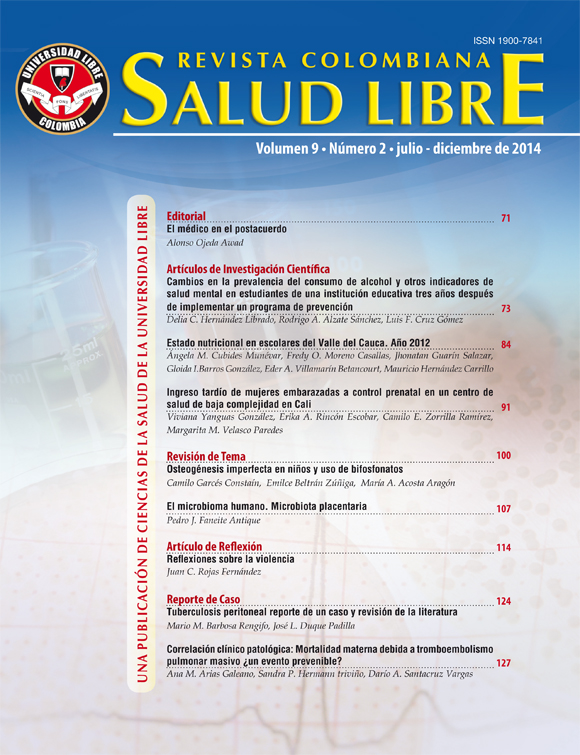Hipofosfatasia
DOI:
https://doi.org/10.18041/1900-7841/rcslibre.2016v11n1.1391Palabras clave:
Fosfatasa alcalina, Hipofostasia, RaquitismoResumen
La hipofosfatasia es una enfermedad congénita caracterizada por una deficiencia de fosfatasa alcalina no específica de tejido, que genera una mineralización anormal del tejido óseo y dental. Las manifestaciones clínicas son variables, desde formas neonatales con alta mortalidad, hasta formas más leves del adulto con fracturas por fragilidad y osteomalacia. El diagnóstico bioquímico se basa en la determinación de valores séricos bajos de fosfatasa alcalina e incremento sérico o urinario de fosfoetanolamina, piridoxal 5’-fosfato y pirofosfato inorgánico. El tratamiento ha tenido resultados limitados. Dentro de estos se ha estudiado la administración de hormona paratiroidea en la hipofosfatasia del adulto y el tratamiento de sustitución enzimática con una forma soluble de fosfatasa alcalina recombinante humana en las formas clínicas más graves.Descargas
Los datos de descarga aún no están disponibles.
Referencias
1. Rathbun JC. Hypophosphatasia; a new developmen- tal anomaly. Am J Dis Child. 1948; 75: 822-31. URL disponible en: https://www.ncbi.nlm.nih.gov/ pubmed/18110134
2. Mornet E, Nunes ME. Hypophosphatasia. Orphanet J Rare Dis. 2007; 2: 40.
3. Orimo H. The mechanism of mineralization and the role of alkaline phosphatase in health and disease. J Nippon Med Sch. 2010; 77: 4-12. URL disponible en: https://ojrd.biomedcentral.com/ articles/10.1186/1750-1172-2-40 DOI: 10.1186/1750- 1172-2-40
4. Mornet E, Yvard A, Taillandier A, Fauvert D, Simon-Bouy B. A molecular-based estimation of the prevalence of hypophosphatasia in the European population. Ann Hum Genet. 2011; 75 (3): 439-45. URL disponible en: https://www.ncbi.nlm.nih. gov/pubmed/21488855 DOI: 10.1111/j.1469- 1809.2011.00642.x
5. Mornet E, Hofmann C, Bloch-Zupan A, Girschick H, Le Merrer M. Clinical utility gene card for: Hy- pophosphatasia - update 2013. Eur J Hum Genet. 2014; 22 (4). URL disponible en: https://www. ncbi.nlm.nih.gov/pmc/articles/PMC3953904/ DOI: 10.1038/ejhg.2013.177
6. Alonso G, Varsavsky M, Muñoz-Torres M. Hi- pofosfatasia: nuevas perspectivas terapéuticas. Med Clin (Barc). 2009; 132 (3): 108-11. URL dis- ponible en: file:///D:/DIAGRAMACIONES/ SALUD%20-%20LIBRE/SUPLEMENTO%202016/ S0025775308000407_S300_es.pdf DOI:10.1016/j. medcli.2008.09.010
7. Caballero Mora F, Martos Moreno G, García Espar- za E, Argente J. Hipofosfatasia infantil. An Pediatr. 2012; 76: 368-9. URL disponible en: http://www. analesdepediatria.org/es/hipofosfatasia-infantil/ articulo/S1695403312000549/ DOI: 10.1016/j.an- pedi.2012.01.019
8. Sánchez L, Urioste M, Martínez S, _Rodríguez VF, Ayala A, Martínez ML. Hipofosfatasia congénita perinatal: Presentación de tres casos, prevalencia en España y consideraciones sobre el modo de heren- cia. An Esp Pediatr. 1996; 44: 601-4. URL disponible en: https://www.aeped.es/sites/default/files/ anales/44-6-20.pdf
9. Whyte MP, Greenberg CR, Salman NJ, Bober MB, McAliser WH, Wenkert D, et al. Enzyme-replace- ment therapy in life-threatening hypophosphatasia. N Engl J Med. 2012; 366: 904-13. URL disponible en: http://www.nejm.org/doi/full/10.1056/ NEJMoa1106173#t=article DOI: 10.1056/NEJ- Moa1106173
2. Mornet E, Nunes ME. Hypophosphatasia. Orphanet J Rare Dis. 2007; 2: 40.
3. Orimo H. The mechanism of mineralization and the role of alkaline phosphatase in health and disease. J Nippon Med Sch. 2010; 77: 4-12. URL disponible en: https://ojrd.biomedcentral.com/ articles/10.1186/1750-1172-2-40 DOI: 10.1186/1750- 1172-2-40
4. Mornet E, Yvard A, Taillandier A, Fauvert D, Simon-Bouy B. A molecular-based estimation of the prevalence of hypophosphatasia in the European population. Ann Hum Genet. 2011; 75 (3): 439-45. URL disponible en: https://www.ncbi.nlm.nih. gov/pubmed/21488855 DOI: 10.1111/j.1469- 1809.2011.00642.x
5. Mornet E, Hofmann C, Bloch-Zupan A, Girschick H, Le Merrer M. Clinical utility gene card for: Hy- pophosphatasia - update 2013. Eur J Hum Genet. 2014; 22 (4). URL disponible en: https://www. ncbi.nlm.nih.gov/pmc/articles/PMC3953904/ DOI: 10.1038/ejhg.2013.177
6. Alonso G, Varsavsky M, Muñoz-Torres M. Hi- pofosfatasia: nuevas perspectivas terapéuticas. Med Clin (Barc). 2009; 132 (3): 108-11. URL dis- ponible en: file:///D:/DIAGRAMACIONES/ SALUD%20-%20LIBRE/SUPLEMENTO%202016/ S0025775308000407_S300_es.pdf DOI:10.1016/j. medcli.2008.09.010
7. Caballero Mora F, Martos Moreno G, García Espar- za E, Argente J. Hipofosfatasia infantil. An Pediatr. 2012; 76: 368-9. URL disponible en: http://www. analesdepediatria.org/es/hipofosfatasia-infantil/ articulo/S1695403312000549/ DOI: 10.1016/j.an- pedi.2012.01.019
8. Sánchez L, Urioste M, Martínez S, _Rodríguez VF, Ayala A, Martínez ML. Hipofosfatasia congénita perinatal: Presentación de tres casos, prevalencia en España y consideraciones sobre el modo de heren- cia. An Esp Pediatr. 1996; 44: 601-4. URL disponible en: https://www.aeped.es/sites/default/files/ anales/44-6-20.pdf
9. Whyte MP, Greenberg CR, Salman NJ, Bober MB, McAliser WH, Wenkert D, et al. Enzyme-replace- ment therapy in life-threatening hypophosphatasia. N Engl J Med. 2012; 366: 904-13. URL disponible en: http://www.nejm.org/doi/full/10.1056/ NEJMoa1106173#t=article DOI: 10.1056/NEJ- Moa1106173
Descargas
Publicado
2016-06-01
Número
Sección
Artículos de revisión
Cómo citar
Acosta Aragón, M. A., Rodríguez Vélez, G., & Mena Gallego, J. (2016). Hipofosfatasia. Revista Colombiana Salud Libre, 11(1), 98-101. https://doi.org/10.18041/1900-7841/rcslibre.2016v11n1.1391


